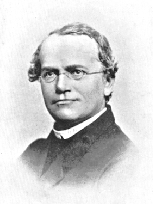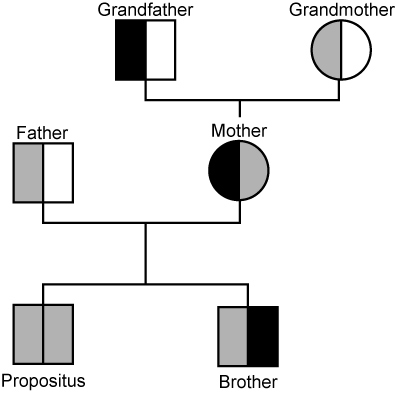 username@email.com
username@email.com
In the upcoming sections, we’ll take a look at genetics and one of the most famous members of the field, Gregor Mendel. We’ll also see how genetic traits get passed along via natural selection.

Long before anything was known about DNA, chromosomes, or genetics, scientists knew traits could be passed from parents to offspring. It was not until Gregor Mendel’s work with garden pea plants that an initial mechanism was proposed. What was critical about Mendel’s approach was that it was experimental and applied the principles of probability.
From studying mitosis and meiosis, you know that crossing over can lead to a shuffling of genes between pairs of chromosomes. Thus, traits can seemingly disappear or offspring can have traits very different from their parents. Even with this shuffling, the basic concepts revealed by Mendel’s experiments provided a foundation for the principles of inheritance including:
Today we know the “units” of inheritance Mendel described are genes carried on chromosomes. Human chromosomes can carry thousands of genes, which are segments of DNA containing specific information for assembling a sequence of amino acids during translation. We also know that clear dominance and recessiveness do not describe all traits. Some can exhibit co-dominance or incomplete dominance, and most traits are polygenic (coded by multiple genes).
We also know that independent assortment of traits occurs only when genes are carried on different chromosomes. Independent assortment occurs because of the basically random alignment (and ability to cross over) of chromosomes during metaphase one of meiosis.
Humans have twenty-three pairs of chromosomes that must line up and separate. Chromosomal disorders such as Down syndrome can occur when paired chromatids (in this case pair twenty-one) fail to separate in meiosis and are then used in fertilization, leaving the offspring with an extra chromosome.
Traits carried on the twenty-third pair are called sex-linked; most are carried on the X chromosome and known as X-linked. Unlike genes on other chromosomes, these do not pass with equal chance to male and female offspring. Because males have only one X chromosome in pair twenty-three, they cannot pass such traits down to male offspring.
This can be illustrated using the pedigree for color blindness shown below. Color blindness is an X-linked trait expressed mainly in males.

A color-blind father has two daughters, each with normal vision. What chance will these daughters have of passing the color-blind gene to one of their sons?
The correct answer is A. Since the father has the trait on his X chromosome, he will pass this to all female offspring. Both girls have normal vision but are carriers; therefore, they have a 50% chance of having a color-blind son.
Evolution can be defined as changes in physical or behavioral characteristics (or both) of individuals in a population over time. The amount of time required for change can obviously be very long, although some changes have been observed in just a few generations of rapidly reproducing species.
The mechanism for evolutionary changes is the process of natural selection first proposed independently by both Charles Darwin and Alfred Russell Wallace. In traveling aboard the HMS Beagle, Darwin noted many physical adaptations among populations of similar species and began to think about how such features arose.
The basic tenets of natural selection include:
As the environments in which organisms live (and the various forces acting on these populations) change, those organisms with traits better suited for survival and reproduction will leave more offspring in future generations. Over time, populations will include more species with these traits, and less-suited traits may disappear.
Since the only variations that can be passed directly to offspring are heritable, natural selection acts upon the genetic traits. Over time, three basic patterns of selection can occur: stabilizing, directional, and disruptive. Directional selection occurs when populations shift toward one extreme or another for any given trait (e.g., size). Disruptive selection acts against the intermediate trait in favor of both extremes. Stabilizing selection acts against the extremes, making organisms more similar.
Other forms of variation come from learned behavioral adaptations to the environment. Some of these traits can be taught to young ones, although they may not be passed down genetically. For example, a bear cub learns much about hunting from traveling with its mother. An older, more experienced mother is likely to be a more effective hunter and a better provider for her offspring than a new, young mother. However, this variation is not necessarily heritable unless the behavior is somehow coded in the genes.
Evidence points to the age of Earth as being about four billion years. The surface four billion years ago was extremely harsh and inhospitable to any type of life, but about that same time, Earth began to retain water on its surface. The materials required for the formation of organic molecules were present in the prototypic oceans and atmosphere. Scientists have demonstrated, under laboratory conditions, that molecules like amino acids can be formed if the requisite ingredients are present and they are subjected to sufficient energy. Lightning and volcanic eruptions were common on Earth at that time, and in waters of the early surface, self-replicating molecules (nucleic acids) were formed.
The formation of these molecules was not entirely random but actually fairly probable given the physical conditions at the time. Experiments have also shown that in heated water, amino acids will form protein chains that when cooled can form selectively permeable spheres—a likely precursor to the plasma membranes we recognize today.
As conditions eventually quieted on Earth’s surface, fossils of living organisms formed. Rocks as old as 3.5 billion years contain fossils of prokaryotic cells resembling bacteria found in tidal mudflats today. As photosynthetic bacteria evolved around 2.5 billion years ago, the atmosphere began to change markedly and it became suitable for many more life-forms.
Over subsequent years, climate changes, catastrophes, and other factors have brought about numerous changes and the extinctions of once-living organisms. The best-known of these catastrophes is an asteroid impact that occurred sixty-five million years ago. According to some theories, that impact greatly cooled Earth, brought about the extinction of the dinosaurs, and ushered in the age of mammals. There have been other events and changes in Earth’s climate. In fact, most species that have existed on Earth are now extinct.
Today, as DNA analysis has become available, we have been able to identify relationships among existing organisms, revealing common ancestry or lack thereof, and thus further filling in the gaps in our knowledge.
The fact that most living organisms that have evolved are now extinct reflects which of the following?
The correct answer is C. As changes in climate, continental drift, competition for resources, and many other factors place pressures on existing species, many are unable to evolve and adapt and eventually become extinct.